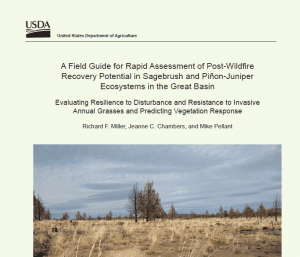Post-fire Environment & Management
View article.
This study explored recovery of Wyoming big sagebrush (Artemisia tridentata ssp.wyomingensis) and basin big sagebrush (A. tridentata ssp. tridentata) communities following fire in the northern Columbia Basin (Washington, USA). Density of large–mature big sagebrush plants and percentage cover of big sagebrush were higher with time since fire and in plots with more precipitation during the winter immediately following fire, but were lower when precipitation the next winter was higher than average, especially on soils with higher available water supply, and with greater post-fire mortality of mature big sagebrush plants. Bunchgrass cover 5 to 28 years after fire was predicted to be lower with higher cover of both shrubs and non-native herbaceous species, and only slightly higher with time. Post-fire recovery of big sagebrush in the northern Columbia Basin is a slow process that may require several decades on average, but faster recovery rates may occur under specific site and climate conditions.
View abstracts.
These abstracts of recent papers on rangeland management in the West were prepared by Charlie Clements, Rangeland Scientist, USDA Agricultural Research Service, Reno, NV.
View article.
This study evaluated the effects of fire on biological soil crusts of early-seral juniper. Compared with unburned plots, the biomass of cyanobacteria was diminished under juniper and sagebrush; it was reduced in the interspaces in both burned and unburned plots, presumably in response to generally harsher conditions in the postburn environment. Nitrogen fixation rates declined over time in juniper plots and interspaces but not in sagebrush plots. Although fire negatively affected some biological soil crust organisms in some parts of the early-seral juniper woodland, the overall impact on the crusts was minimal. If the intent of burning is to reduce juniper, burning of early-seral juniper woodland is appropriate, as most affected trees were killed. Burning early-seral juniper may be preferred for controlling juniper encroachment on rangeland.
View field guide.
This field guide provides a framework for rapidly evaluating post-fire resilience to disturbance, or recovery potential, and resistance to invasive annual grasses, and for determining the need and suitability of the burned area for seeding. The framework identifies six primary components that largely determine resilience to disturbance, resistance to invasive grasses, and potential successional pathways following wildfire, as well as the information sources and tools needed to evaluate each component.
The components are: (1) characteristics of the ecological site; (2) vegetation composition and structure prior to the wildfire; (3) fire severity; (4) post-wildfire weather; (5) post-wildfire management, especially grazing; and (6) monitoring and adaptive management.
The tools provided are: (1) a conceptual model of the key components that largely determine resilience to disturbance and resistance to invasive annual grasses of the burn area, (2) a guide to evaluate post-wildfire severity, (3) indicators to estimate pre-wildfire plant composition and structure if not known, and (4) an evaluation score sheet to rate an area’s potential post-wildfire resilience to disturbance, resistance to invasive annual grasses and, thus, the need for seeding and probability of success.
View abstracts.
These abstracts of recent papers on rangeland management in the West were prepared by Charlie Clements, Rangeland Scientist, USDA Agricultural Research Service, Reno, NV.
View report.
This final report includes actions to be implemented by Interior’s bureaus to immediately address the threat of rangeland fire and other disturbances to Western sagebrush-steppe landscapes and improve fire and fuels management efforts.
View article.
This study monitored the habitat-use patterns of 71 radio-marked sage-grouse inhabiting an area affected by wildfire in the Virginia Mountains of northwestern Nevada during 2009–2011 to determine the effect of micro-habitat attributes on reproductive success. Sage-grouse selected micro-sites with greater shrub canopy cover and less cheatgrass (Bromus tectorum) cover than random sites. Total shrub canopy, including sagebrush (Artemisia spp.) and other shrub species, at small spatial scales (0.8 ha and 3.1 ha) was the single contributing selection factor to higher nest survival. These results indicate that reducing the risk of wildfire to maintain important sagebrush habitats could be emphasized in sage-grouse conservation strategies in Nevada. Managers may seek to mitigate the influx of annual grass invasion by preserving large intact sagebrush-dominated stands with a mixture of other shrub species. For this area of Nevada, the results suggest that ≥40% total shrub canopy cover in sage-grouse nesting areas could yield improved reproductive success.
View research brief.
This research brief summarizes a series of interviews with land managers who make decisions about post-fire rehabilitation and restoration. These interviews explored barriers to improving post-fire recovery that included: policies and funding cycles that constrain managers’ ability to monitor and re-treat effectively, pressure and legal action from interest groups, pressure from concerned public/neighbors, climate change, and
ecological debates such as native vs. non-native species use. These identified barriers provide a social-political-ecological framework that may influence on-the-ground manager decisions after wildfires in the Great Basin.
View report.
The initial report includes actions to be implemented by Interior’s bureaus to immediately address the threat of rangeland fire to Western sagebrush-steppe landscapes and improve fire management efforts before the start of the 2015 wildfire season.
View the Order.
This Order sets forth enhanced policies and strategies for preventing and
suppressing rangeland fire and for restoring sagebrush landscapes impacted by fire across the West. These actions are essential for conserving habitat for the greater sage-grouse as well as other
wildlife species and economic activity, such as ranching and recreation, associated with the sagebrush-steppe ecosystem in the Great Basin region.


